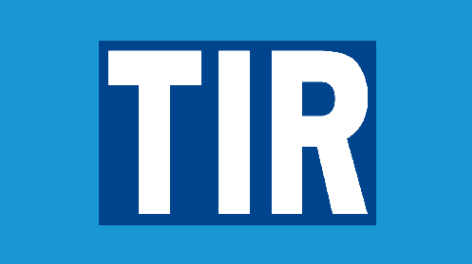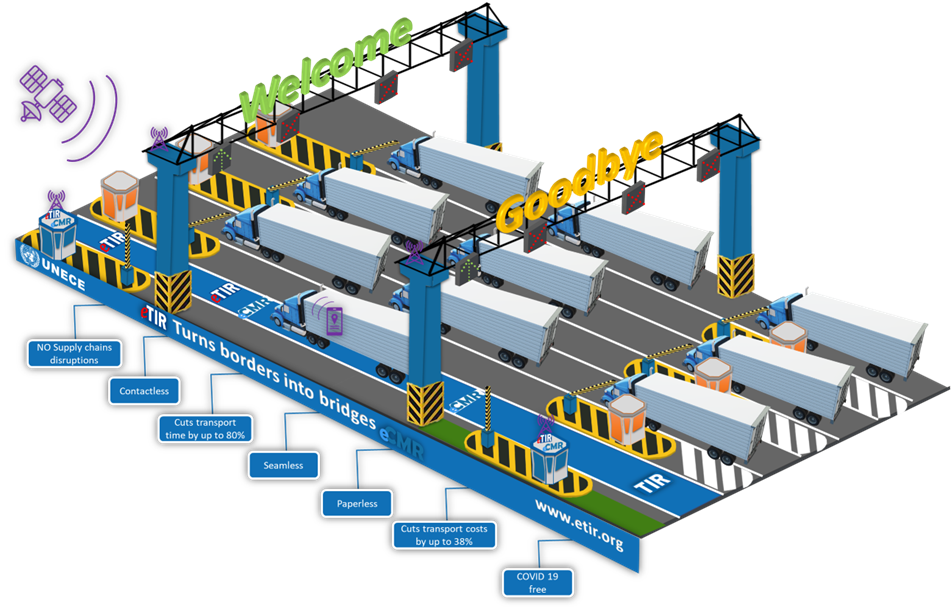
When countries around the world began closing borders and imposing lockdowns due to the Covid-19 pandemic, the global supply chains were deeply affected. With customers buying in bulk out of fear, shops struggled to restock their shelves. At that moment, everyone realised that border crossing facilitation is key to our lives and economies independently of pandemics.
There are various UN conventions that govern the transport of goods across borders, ensuring a smooth and efficient transit through customs. However, when countries are obliged to implement strict border measures, these usual conditions which apply to transport were set aside. In the case of the Covid-19 pandemic, this resulted to thousands of trucks being stuck at borders, leading to shortages in food and other essential goods. It also led to inhumane conditions for truck drivers and customs officials who were stuck for days and weeks, without access to necessities and their families.
Perhaps one of the most well-known of the transport conventions is the customs Convention on the International Transport of Goods under Cover of TIR Carnet - or the TIR Convention. You may have seen the blue TIR sign on the back of trucks all over Europe and Asia. This convention allows trucks to transit through multiple countries without being stopped and examined by the customs until they reach the destination country. This system is used by 78 countries around the world and facilitates the seamless transport of millions of tons of goods each year – anything from medicine to food and other necessities.
Everything you need to know about the TIR Convention – the TIR Handbook.
The eTIR International System was recognised as the UN tool / convention that protects people from Covid-19 while facilitating and simplifying borders crossing procedures by the UN system and governments. The United Nations (UN) Secretary-General’s report entitled “Shared responsibility, global solidarity: Responding to the socioeconomic impacts of COVID-19”, published in March 2020 mentions: “Innovative tools such as UN eTIR/eCMR systems and other tools that allow the exchange of electronic information without physical contact and facilitate the flow of goods across borders should be used”.
Furthermore, after our initial call to implement eTIR procedure (7 April 2020), 10 countries plus the European Union have so far responded positively, to connect their National Systems to the eTIR International System. As a result, one after the other, the contracting parties to the TIR Convention are connecting their national customs systems to the eTIR international system developed and hosted by the TIR secretariat.
The interconnection of national customs systems to the eTIR international system and the implementation of the eTIR procedure will clearly turn borders into bridges.

The applications that constitute the eTIR system are presented in Table 1. All applications are interconnected and have been designed to disseminate data for transport documents.
|
Application
|
Description
|
|---|---|
|
eTIR international system
|
It is the main application of the eTIR. It has been developed by the TIR secretariat and it is hosted by UNECE. All customs authorities and the private sector (IRU) will be interconnected to the eTIR international system and exchange data every time a TIR event is happening.
|
|
International TIR Data bank
|
ITDB is developed and hosted by the TIR secretariat. All customs authorities and National Road transport associations are connected to ITDB. It is the system where customs approve new users of the TIR system and provide all information about withdrawal of users and customs seals photos. It currently includes data for more than 40,000 trucking companies using the TIR system.
|
|
eTIR National Application
|
The TIR secretariat developed the eTIR national application to reduce the time required for a national customs system to interconnect to the eTIR international system. It is provided at no cost to customs authorities and is interconnected already to the eTIR international system.
|
|
eTIR mobile applications for the drivers and customs officers
|
The TIR secretariat prepared mobile applications for the vehicles drivers and the customs officers which include the eTIR/ITDB data. The only thing that the customs officers have to do under the eTIR procedure when a commercial vehicle arrives at the borders would be to scan with their mobiles the QR Code in the mobiles of the vehicles’ drivers and get all the information required.
|

The flow of data and documents (Figure 8) is as follows:
Everything about the TIR international system can be found in the eTIR specialized website www.etir.org.
|
Goal
|
Contribution
|
|---|---|
|
|
Trade and transport facilitation measures directly help informal businesses to better participate in foreign trade. General provisions, such as transparency, which is being achieved with the implementation of the electronic TIR procedure, are also critical for integrating smaller firms into global value chains (SDG target 8.3).
Digital trade and transport measures, i.e. electronic submissions of declarations, reduce the time goods spend at borders, support achieving higher levels of economic productivity through diversification, technological upgrading and innovation (SDG target 8.2).
|
|
|
The deployment of digital technologies and the implementation of the computerized procedures of well-known UN Conventions (TIR) have become a positive enabler for national economies, facilitating business continuity and connecting electronically traders with the transport industry, customs authorities and border agencies.
Sharing good practices to develop quality, reliable, sustainable and resilient infrastructure, including regional and transborder infrastructure that serves digitalised border crossing procedures (SDG target 9.1).
Reducing cumbersome procedure to improve the efficiency of transit, especially crucial for LDCs and LLDCs.
|
|
|
The TIR system is one of the very first public private partnerships in the UN system since the operations of the international guarantee of the system is mandated by the governments to be provided by the International Road Transport Union (IRU). It will also strengthen public-private coordination platforms at the national and regional levels, providing the necessary multi-stakeholder consultative mechanism for the trade and transport recovery plan.
|
|
Goal
|
Contribution
|
|---|---|
|
|
The simplification of procedures and standardisation of fees and charges applicable to trade will foster more predictable, higher levels of revenue collection for customs, ensuring significant mobilisation of resources from a variety of sources.
|
|
|
The TIR system facilitates and speeds up the transport, transit and clearance of critical protection goods such as medicines contributing to good health and well-being targets.
|